#Helodermatidae
Text

Gila Monster (Heloderma suspectum), family Helodermatidae, SW United States
Mildly venomous.
photograph by Greg Lit
#gila monster#heloderma#helodermatidae#lizard#veonmous#reptile#herpetology#animals#nature#north america
751 notes
·
View notes
Photo

Guatemalan beaded lizard (Heloderma charlesbogerti) in Zacapa, Guatemala
Oleg Chernyshov
2K notes
·
View notes
Text

A gila monster (Heloderma suspectum) wanders through a backyard in the Sonoran Desert, Arizona, USA
by troupial
#gila monster#beaded lizards#lizards#reptiles#heloderma suspectum#heloderma#helodermatidae#squamata#reptilia#chordata#wildlife: arizona#wildlife: usa#wildlife: north america
169 notes
·
View notes
Text
Uncharismatic Fact of the Day
Gila monsters may look ferocious, but they’re really quite lazy. These lizards spend most of their day soaking up the sun to maintain their internal temperature, and a group of them is called a lounge.

(Image: A lazy gila monster (Heloderma suspectum) by the National Park Service of the United States)
If you like what I do, consider leaving a tip or buying me a kofi!
323 notes
·
View notes
Note
I think if Helodermatidae "Helen" Hidgens transitioned later in life (like late enough for a child Neptune to be able to remember her pre-transition) there would definitely be at least one moment where she stumbles upon Neptune in the middle of a phone call with some random guy, saying "What do you MEAN, I've ALWAYS had an Aunt Hidgens!!! Are you feeling alright?! I think you need to lie down or something." and basically just gaslighting this poor random guy into thinking Helen's a cis woman. And when he realizes that she's there, they just turn around and look at her like

...hy thinks she'd appreciate the tomfoolery so. Yeah. 👍
YAAAY NEPPY AND HELEN CONTENT
I love this!!!
3 notes
·
View notes
Text
did you know that helodermatidae (gila monster & mexican beaded lizards) are distant cousins of varanidae (monitor lizards) and these are the two groups of lizards that today have active venom production?
today helodermatidae is restricted in range to the sonoran desert, mexico, and guatemala, but in the past was far more widespread. They have been found in places such as what is now called florida (unnamed genus), and some have even been found in europe (genus Euheloderma) and mongolia (Estesia mongoliensis). the family could date as far back as the cretaceous period (if Estesia is considered basal Helodermatidae rather than within a closely related ancestral family), and several species are known by the oligocene period.
9 notes
·
View notes
Text
Gila Canavarı Nedir? Nerede Yaşar? Özelikleri Nelerdir?
Gila Canavarı Nedir? Nerede Yaşar? Özelikleri Nelerdir?
Gila canavarı dünya genelinde kertenkele türleri arasında zehirli olma özellikleri ile tanınan bir türdür. HELODERMATİDAE ailesinin üyesi olan gila kertenkelesinin büyün vücudunu kapsayan boncuğa benzeyen bir yapı ile kaplanmıştır. Oldukça dayanıklı bir kafa yapısına sahip olan gila kertenkelesinin alt ve çene kaslarında zehir beşleri bulunurken etkili bir fiziğe sahiptir. Gila kertenkelesinin en…
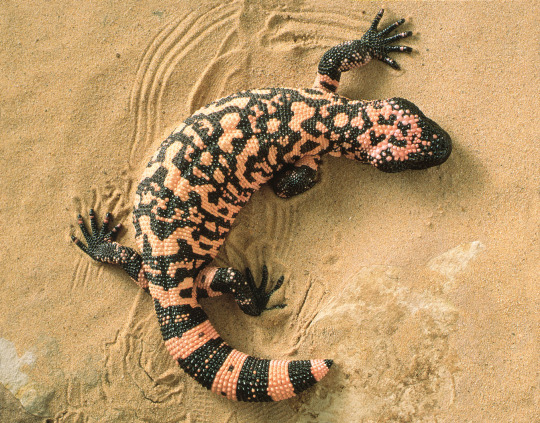
View On WordPress
0 notes
Photo
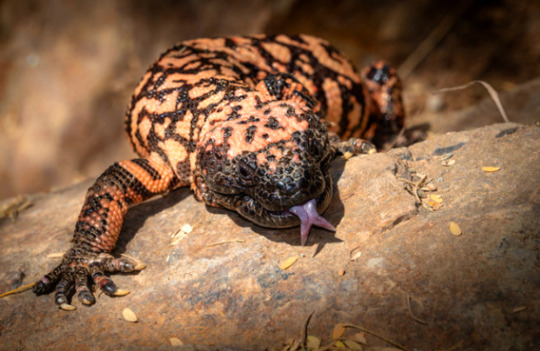
Gila Monster
Heloderma suspectum
#gila monster#lizard#squamata#squamates#reptilia#reptile#herp#helodermatidae#venomous#herpetology#zoology#wildlife#animals#animal#nature#scales#tongue#reptiles#herps
30 notes
·
View notes
Text

Mexican Beaded Lizard (Heloderma horridum), family Helodermatidae, Mexico
Venomous.
photograph by @vibes.and.snakes
344 notes
·
View notes
Text
Is this what they call overkill? Toxin and venom in the herp world

Figure 1. Bufo japonicus. The large glands behind the eyes are called parotid glands, and are a source of toxins in toads. Additionally, all of the bumps you see all over the body are glands that produce skin toxins. Image credit: Stevie Kennedy-Gold.
I recently participated in a Zoom event for Museum members focused on toxins and venom in the natural world. Mason Heberling, Assistant Curator of Botany, and Ainsley Seago, Associate Curator of Invertebrate Zoology, spoke about how the organisms they study produce toxins, and how these chemicals impact their environments and other organisms around them. As an ecologist focused on impacts of climate and land use change, I don’t consider myself an expert on toxins and venoms in amphibians and reptiles, but researching my portion of the joint presentation reminded me once again why herps are the best.
First, a refresher: toxins are poisons, and they have to be consumed or encountered (touched) by an organism to do harm. For example, many frogs produce toxins in their skin, but you would have to either consume that frog or touch its skin for the toxin to do you any harm. Most frogs don’t produce toxins strong enough to hurt humans, though a few notable exceptions exist. Some species of poison dart frogs have skin toxins strong enough that if you touched them and then touched your eyes, nose, or mouth, or if you had a cut on your hand, you could indeed become very ill and perhaps die. Venom, on the other hand, is a toxin that one organism can inject into another. Typically, we think of snakes when we think of injectable toxins. Many snake species have venom glands that produce toxins, and they can forcibly inject that toxin into their prey. The action, which can occur in a flash, involves the use of fangs to puncture the skin, and muscles surrounding the venom gland to force the toxin out along the fang and into the other organism.
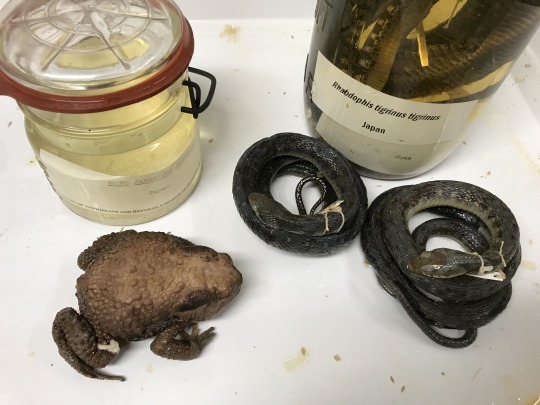
Figure 2. Bufo japonicus and Rhabdophis tigrinus. Rhabdophis are one of the only snakes that are both venomous and toxic. They sequester toxins from the toads they eat into a gland called the nuchal crest. Image credit: Stevie Kennedy-Gold.
Most people tend to think of amphibians as toxic and snakes as venomous. This is true, but it turns out that snakes aren’t the only venomous reptiles, and amazingly two frogs are known to be venomous. Gila monsters (Helodermatidae) and water monitors (Varanidae) produce venom, but their venom glands are in their lower jaws (unlike snakes whose venom glands are in their upper jaws), and they lack the muscles to forcibly inject that toxin the way snakes do. Instead, the act of chewing on their prey causes their jaw motion to work the venom toward their grooved teeth, which then enables the venom to be injected through the bite wound. Using a very different delivery system, two frogs in the family Hylidae (tree frogs from the Americas) have very spiny skulls. Their skin produces toxins, and by “head-butting” another organism, they can effectively inject that toxin into another organism. This unusual delivery system technically makes them both toxic (the toxin can be transferred to you if you touch their skin) and venomous (they can inject that toxin into you).

Figure 3. Rhabdophis tigrinus. If you look closely at the back of the neck just behind the head on the snake on the left, you can see a slightly raised bit of skin, which is the nuchal crest used to store toxins sequestered from toads. Image credit: Stevie Kennedy-Gold.
One of the most surprising things I learned is that there are snakes that are both toxic and venomous, and these are snakes I see frequently in the field. The genus Rhabdophis is common across South and Southeast Asia, and have long been known to be venomous. What I didn’t know is that in addition to making their own venom, they sequester toxins from their prey, and store it in a gland on the back of their neck called a nuchal crest. Rhabdophis feed on toads, which are toxic, and the snakes are able to sequester that toxin, rather than being adversely affected by it. Interestingly, scientists have shown that Rhabdophis tigrinus are toxic only where their range overlaps with Bufo japonicus, a highly toxic toad—so on some islands of Japan the snakes are toxic, while on other islands they are not.
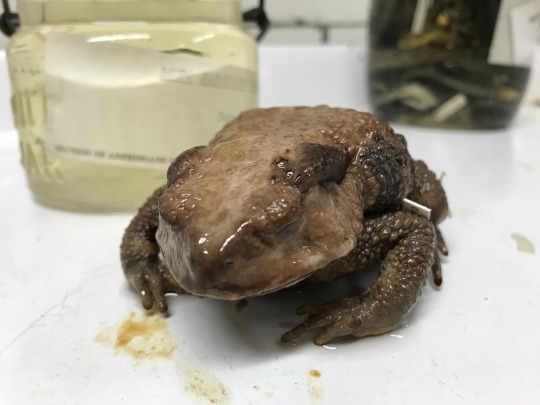
Figure 4. Bufo japonicus with its many toxin glands! Image credit: Stevie Kennedy-Gold.
There are numerous other interesting adaptations involving toxin and venom in the herp world—tweet me (@JenASheridan) if you want to learn more!
Jennifer Sheridan is Assistant Curator in the Section of Amphibians and Reptiles at Carnegie Museum of Natural History. Museum employees are encouraged to blog about their unique experiences and knowledge gained from working at the museum.
43 notes
·
View notes
Text
กิล่ามอนสเตอร์
อาณาจักร : Animalia
ไฟลัม : Chordata
ชั้น : Reptilia
อันดับ : Squamata
อันดับฐาน : Neoanguimorpha
วงศ์ : Helodermatidae Gray, 1837
สกุล : Heloderma Wiegmann, 1829

กิล่ามอนสเตอร์ (Gila monster) เป็นกิ้งก่ามีพิษชนิดหนึ่งที่เรามักจะพบได้ตามเขตทะเลทรายทางตะวันตกเฉียงใต้ของสกรัฐอเมริกา ในเขตทะเลทรายอริโซน่า โดยมีขนาดความยาวประมาณ 60 ซม.หรือ 2 ฟุต นับได้ว่าเป็นกิ้งก่ามีพิษที่มีขนาดใหญ่ที่สุดในโลก โดยมีลักษณะสีที่ลำตัวลายดำ ส้ม ชมพู เหลือง ลักษณะนิสัยที่เชื่องช้าชอบหลบอยู่อาศัยในโพรง ส่วนพิษของพวกมันจะมีต่อผลิตที่สามารถเข้าไปทำลายระบบประสาทของเหยื่อ โดยพิษที่มีนั้นจะส่งผ่านไปยังฟันกรามล่าง แต่พิษนี้ไม่มีผลต่อมนุษย์หรือเป็นอันตรายถึงแก่ชีวิตได้แต่ก็สร้างความเจ็บปวดได้

ลักษณะกิล่ามอนสเตอร์
กิล่ามอนสเตอร์ หรือ Gila Monster มีรูปร่างหน้าตาที่ชวนขนลุก แต่ในความจริงพวกมันเป็นกิ้งก่าชนิดหนึ่งที่อาศัยอยู่ในแถบแอริโซน่าหรือเม็กซิโก พวกมันมีร่างกายที่เป็นตะปุ่มตะป่ำที่ทำหน้าที่เหมือนเกราะให้กับมัน กิล่ามอนสเตอร์มีลำตัวสีดำตัดด้วยสีส้มหรือสีเหลือง หางของกิล่ามอนสเตอร์จะมีลักษณะอ้วนกลม มีความยาวได้ถึง 2 ฟุต แต่พวกมันจะมีขาสัตว์อยู่ทั้ง 2 ข้างของลำตัว หรือหากจะอธิบายให้คุณได้เห็นภาพง่ายๆ ก็คือ พวกมันมีลักษณะคล้ายๆ กับตุ๊กแก นั่นอาจจะช่วยให้คุณนึกถึงความน่าขนลุกของพวกมันได้ง่ายขึ้น
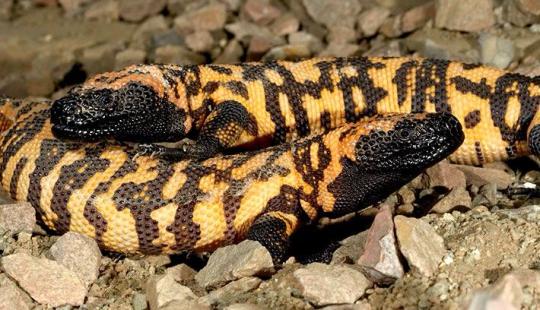
พิษของกิล่ามอนสเตอร์
พิษของกิล่ามอนสเตอร์ ร้ายแรงพอๆ กับงูหางกระดิ่ง นี่อาจเป็นอีกหนึ่งความเชื่อที่หลายคนมักจะนึกถึงเมื่อมีการกล่าวถึงพวกมัน เป็นเรื่องจริงที่กิล่ามอนสเตอร์มีต่อมพิษอยู่ที่ต่อมน้ำลาย นั่นหมายถึงพวกมันจะสามารถสร้างพิษได้เอง พิษของกิล่ามอนสเตอร์จะมีความรุนแรงส่งผลต่อระบบประสาท แต่พิษของกิล่ามอนสเตอร์อาจไม่ได้ร้ายแรงพอที่จะทำให้มนุษย์ถึงแก่ชีวิต แต่ก็สามารถส่งผลให้มนุษย์บาดเจ็บร้ายแรงได้เลยทีเดียว พิษของพวกมันจะถูกส่งผ่านกรามที่แข็งแรงในขณะที่กำลังต่อสู้กับเหยื่ออาหาร ที่ส่วนใหญ่มักจะเป็นสัตว์จำพวกนกขนาดเล็ก จิ้งจก กบ แมลง ไปจนถึงไข่ของสัตว์ชนิดต่าง ๆ

นอกจากนั้นการจู่โจมของ Gila Monster ช่างน่าสะพรึงด้วย โดยมีคำเล่าลือว่าหากใครที่โดนเจ้ากิล่ามอนสเตอร์เข้า ก็นับว่าโชคร้ายมากเพราะพวกมันจะไม่ปล่อยจนกว่าตะวันจะตกดิน นอกจากเจ้ากิล่ามอนสเตอร์ นับว่าเป็นกิ้งก่าพิษชนิดหนึ่งแล้ว พวกมันยังนับว่าเป็นสัตว์เลื้อยคลานที่มีการจู่โจมที่ค่อนข้างร้ายกาจมากด้วย ในขณะที่พวกมันโกรธหรือพยายามป้องกันตัว กิล่ามอนสเตอร์จะพองตัวของมันและอ้าปากใส่พร้อมด้วยเสียงขู่ฟ่อๆ ที่น่าขนลุก ถึงแม้ว่าเจ้ากิล่ามอนสเตอร์ จะดูร้ายกาจ หรือน่าขนลุกสักแค่ไหน แต่บรรดาผู้ที่ชื่นชอบการเลี้ยงสัตว์แนวเอ็กโซติกก็คงไม่พลาดการได้ครอบครองเจ้ากิ้งก่าสายพันธุ์นี้สักตัวหนึ่ง เพราะหากคุณรู้วิธีที่จะจัดการกับมันอย่างถูกต้องแล้ว เจ้ากิล่ามอนสเตอร์ก็ดูเหมือนจะเป็นสัตว์เลี้ยงที่ดูน่าเกรงขามไม่น้อยเลยทีเดียว

การสืบพันธุ์และลูกหลาน
สัตว์ประหลาดก่ามีอายุครบ 3-5 ปี ฤดูผสมพันธุ์อยู่ในช่วงต้นฤดูร้อนเมื่อตัวผู้แข่งขันโดยเข้าร่วมการแข่งขันมวยปล้ำ ตัวเมียขุดหลุมและคลุมไข่ 2-12 ฟองโดยเฉลี่ยน้ำหนัก 1.4 ออนซ์และมีขนาด 2.5 x 1.2 นิ้วโดยเฉลี่ย ประมาณ 4 เดือนต่อมาไข่ก็ฟักออกมาและสัตว์ประหลาดก่าขนาดเฉลี่ย 6.3 นิ้วก็โผล่ออกมา พวกมันดูเหมือนผู้ใหญ่ตัวจิ๋วที่มีสีสันสดใสกว่าและเป็นของตัวเองตั้งแต่แรกเกิด เด็ก ๆ เหล่านี้จะเติบโตกลายเป็นสิ่งมีชีวิตรายวันที่ใช้ชีวิตส่วนใหญ่อยู่ใต้ดินโดยมีกิจกรรมมากมายในช่วงฤดูใบไม้ผลิซึ่งใช้ไปกับการล่าสัตว์เป็นอาหาร อาหารมื้อใหญ่สามถึงสี่มื้อจะเป็นอาหารทั้งหมดที่จำเป็นสำหรับการดำรงชีวิตในฤดูหนาว พวกมันส่วนใหญ่เป็นสัตว์ที่อยู่โดดเดี่ยว แต่รวมตัวกันเป็นชุมชนเล็ก ๆ ในช่วงฤดูผสมพันธุ์
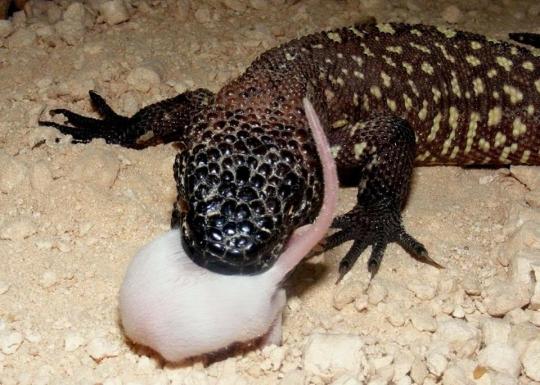
ขอขอบคุณผู้สนับสนุนหลักอย่างเป็นทางการเว็บ Fast98 เป็น สล็อตฟรีเครดิต ไม่ผ่านเอเย่นต์ ฝาก-ถอนระบบออโต้ มีแอดมินบริการตลอด 24 ชั่วโมง
0 notes
Link
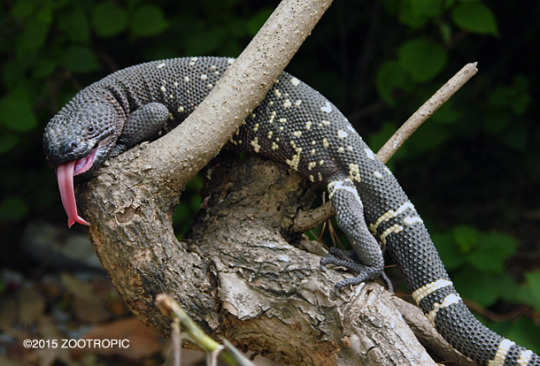
The Guatemalan Beaded lizard, Heloderma horridum charlesbogerti Campbell & Vannini (1988), is an endemic subspecies with a very restricted distribution in the arid portions of the Motagua Valley in Guatemala. It belongs to the Helodermatidae, a unique family of lizards with venom glands. Their closest living relatives are the Varanids. The Guatemalan Beaded Lizard is critically in danger of extinction due to habitat destruction for subsistence farming, illegal collection of specimens for international and local collectors and extermination by local people based on long-held, but false, beliefs regarding the nature of its venom. Little research had been done until the studies of Ariano (2003) and Ariano & Masaya (2005) on the subspecies’ distribution, ecology, and conservation status. The total remaining wild population is estimated at fewer than 200 specimens.
The surviving thornscrub and tropical dry forest habitat of the Guatemalan Beaded Lizard (a mere 17,000 hectares) is considered in the classification developed by the World Wildlife Fund (Dinerstein et to. 1995) to be an ecoregion of special concern based on the singularity of its biota. Isolated on all sides by massive cloud-forested mountains and rainforest valleys, the Beaded Lizards have evidently existed in total isolation in this tiny island of desert habitat for many thousands of years.
47 notes
·
View notes
Text
seriously trying very hard to hold myself back from going into a rabbithole of helodermatidae phylogeny and systematics and downloading papers on it
6 notes
·
View notes
Text
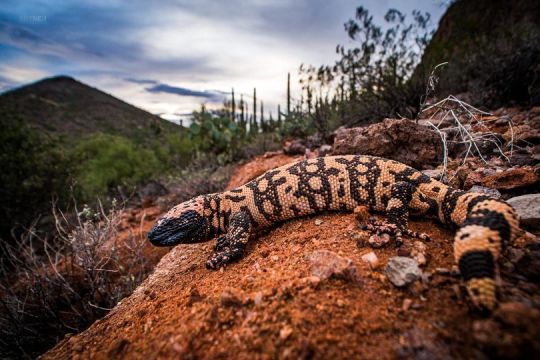
Gila Monster (Heloderma suspectum), family Helodermatidae, Arizona, USA
Mildly venomous.
photograph by @ertner_herpetology
310 notes
·
View notes